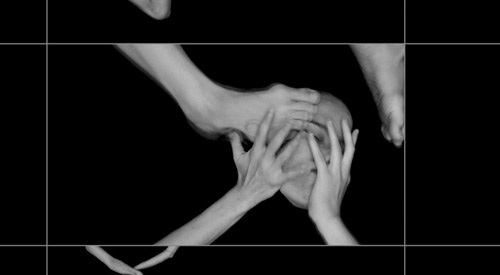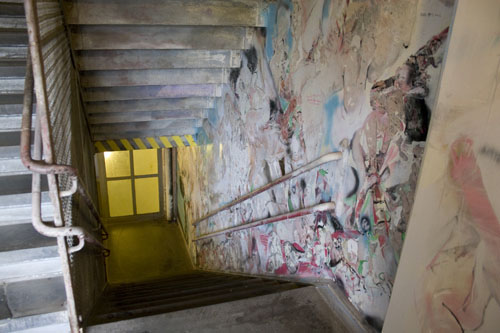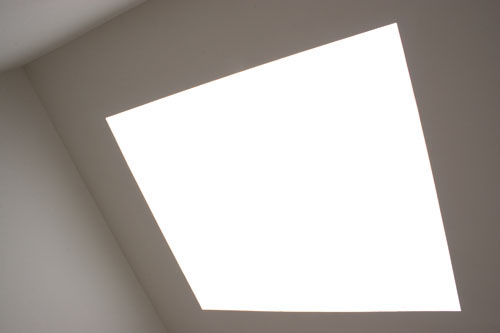I’m in New York, and am surprised to discover a quiet stairwell as one of my favorite sites at MoMA PS1. Tucked away in the museum’s northwest corner, the stairwell houses Vertical Painting, a permanent installation featuring the work of three artists: William Kentridge, Cecily Brown and Alexis Rockman. Ascending multiple flights of stairs, the installation climbs walls that accompany the viewer, their closeness defying a sense of order. In part because of this, they convey a unique sense of intimacy and accessibility.
Tracing and retracing these steps, I am reminded of a short story by Jorge Luis Borges. In The Library of Babel, Borges conceives of a universe in the form of a vast library with an indefinite number of interlocking hexagonal galleries. Within its endless network of rooms sprawling both above and below, each gallery reveals walls dominated by rows upon rows of bookshelves. Though the order and content of the books in the library is random and its code defies interpretation, the inhabitants persist in exploring its staircases and corridors in search of meaning.
“If an eternal traveler should journey in any direction, he would find after untold centuries that the same volumes are repeated in the same disorder – which, repeated, becomes order: the Order.” –Jorge Luis Borges
In considering both the physical qualities of this unique space at PS1 and Borges’ universe of books, I recognize interesting parallels to recent movement and developments in my own practice. Since leaving LA in August to embark upon a three-month circuit of residencies, travels and preparation for upcoming shows, any sense of normalcy or routine has largely gone out the window. Frankly, it’s been that way since leaving graduate school over a year ago. Yet, such disorder has been trumped by the rewards of embracing the intensity and intimacy of this phase. At least for now, this is the new Order.
I continued upstairs at PS1 to check out Meeting, a site-specific piece by James Turrell. The installation is one of Turrell’s series of “skyspaces” featuring enclosed spaces with rectangular or rounded holes cut to expose the open sky. In this site, the installation is presented as a square room with a rectangular opening cut directly into the ceiling. Carefully calculated artificial lights produce an orange glow on the white walls of the room, permitting viewers to appreciate the intensity of the sky’s color. Inside, the room is bare with the exception of wood benches bordering the entirety of its four walls.
Lying down on one of these benches and squinting at the frame of a bright though overcast sky, I considered both the simple order of the space and the elements beyond its control. Turrell creates the frame, but it’s what happens inside the frame and the nature of its unpredictability that completes the work. The installation’s viewing hours are dependent upon the weather; a disorderly sky can close its doors. Thinking back to my time in Detroit, I can recall abandoned structures revealing haphazard skylights mimicking Turrell’s skyspaces. With the addition of snow, these spaces were further emphasized by the geometric patterns of weather lying directly beneath them.
As recent MFA graduates moving forward in our practice and in our careers, we continue to learn the contours and feel out the boundaries of our chosen space. Or perhaps, the space that has chosen us. There is a sense of order that we want (or that we think we want), and the inevitable periods of disorder as we also aim to be flexible and open to the opportunities which present themselves. An installation such as Meeting visually represents the creation of such a space. We carry the frame, set the stage, and hope for favorable conditions to help us a bit further along.
These sites are animated by a supporting network of objects–those we create, hold on to and/or destroy to define our practice. In considering movement and how we negotiate our individual paths, I am reminded of a spring episode of the radio show This American Life titled Invisible Made Visible. Its prologue featured the story of a blind man searching for the phone in his hotel room. He described the experience as something like walking around in a first-person video game, where nothing was visible until he touched it. Slowly making his way around the contours of the room, he felt the room into existence and brought some semblance of order to his immediate surroundings.
This literal series of actions also serves as a powerful symbolic representation of process as we seek out and make sense of the places we inhabit. As artists, I believe an important part of our artistic practice is taking this world in, rearranging it, and sending it back out as a question. That said, this rearrangement does not mean greater clarity or a more orderly world. More often, it is just the opposite.
After PS1, I continued on to SculptureCenter to visit their current exhibition, A Disagreeable Object. Taking its title from Alberto Giacometti’s surrealist sculptures, the exhibition explores ongoing themes of desire and repulsion, the familiar and the unfamiliar. Almost a century after the Surrealist movement, contemporary artists continue to struggle with economic crises, technological advancement, and war. Principles related to work, war and daily life have shifted from the physical to the cerebral, from machines to information–but these impulses continue to present “questions about relationships between the present-day status of the economy, the body, domesticity, technology, and eros.”

Aneta Grzeszykowska. “Headache” (video still), 2008. Video, HD DVD, 11:37. Courtesy of Raster Gallery, Warsaw.
Headache, a 2008 video piece by Polish artist Aneta Grzeszykowska, powerfully illustrates this cyclical struggle between order and disorder, discovery and struggle. In this 11 minute video, the disembodied parts of a woman’s body slowly come back to life, rearranging themselves, beating each other up, feeling each other up. They eventually find their way back together only to be torn apart again. The film loops, and the process begins anew. The piece ranges from graceful to erotic, playful to abusive. The range strengthens its resonance, as each gesture heightens the impact of the others. In the end, the piece conveys a sense of both danger and power, a space for freedom as well as frustration.
As in the hexagonal galleries of The Tower of Babel, I believe our lives and artistic practices unfold in a world that is both unlimited and periodic. Some could argue that we are surrounded by a maddening array of material which already exists to “affirm all things, deny all things, to confound and confuse all things,” as Borges states. Yet, in these indefinite stacks, what can there be but room–each unique perspective defying the laws of the grand Library, incrementally expanding the archive which populates its walls. For some of us, it is the very disorder of things during this period that also reveals a valuable opportunity to engage and activate.
We are the imperfect librarians.






